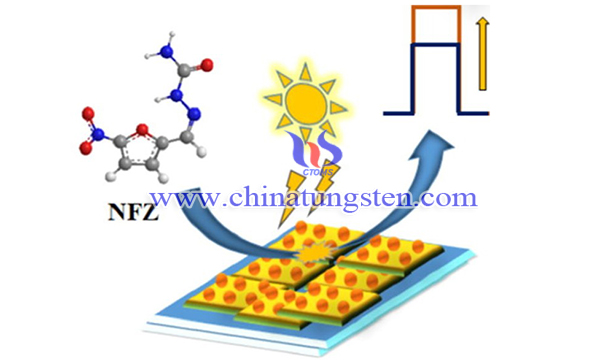WO3/CuMnO2 Nanocomposite for Photoelectrochemical Detection of Nitrofurazone
- Details
- Category: Tungsten Information
- Published on Thursday, 28 October 2021 22:18
As a member of the antibiotic family, nitrofurazone (NFZ) is commonly used to treat burned skin, scratches, and wounds. However, it may cause physical or functional defects in the human embryo or fetus. If it is ingested by humans through the food chain, it can also cause cancer. Therefore, it is prohibited from being used in humans and animals worldwide. As people pay more and more attention to environmental pollution and human health, it is necessary to develop a suitable and sensitive platform to detect NFZ in the environment and water bodies.
Recently, researchers have prepared WO3/CuMnO2 nanocomposite for photoelectrochemical detection of nitrofurazone has been applied for photoelectrochemical detection of nitrofurazone (NFZ). The preparation process is as below:

WO3 nanotiles were synthesized by using CTAB assisted hydrothermal method. In this synthesis, about 2 g of Na2WO4 and a certain amount of CTAB were dissolved in 70 ml of DI water and stirred for an hour to homogenize. To this solution, concentrated HNO3 was added carefully by dropwise to adjust the pH to 3. Finally, the solution was transferred into a 100 ml Teflon-Autoclave hydrothermal pot, and the reaction was initiated at 80 °C for 12 h. The obtained product was washed several times with ethanol and water repeatedly. The received light yellowish powder sample was dried at 80 °C over 24 h and was kept into calcination for 4 h at 450 °C.
The CuMnO2 nanoparticles were prepared by a simple and facile ultrasound-assisted hydrothermal method. For the synthesis, about 360 mg of Cu(NO3)2·3H2O and 380 mg of Mn(NO3)2·3H2O were added in 80 ml of DI water and sonicated for an hour. Then the solution was transferred into 100 ml Teflon autoclave and sealed tightly. Then the hydrothermal reaction was carried out at 120 °C for 24 h. The obtained reddish-brown precipitate was washed with alcohol and DI water several times and oven-dried at 80 °C for 12 h.

The CuMnO2 decorated WO3 nanotiles were prepared by following a simple impregnation method. For the synthesis, 100 mg of WO3 was dispersed in 15 ml of ethyl alcohol by sonication for 30 min. Then aliquot of CuMnO2 particles was added next to the dispersion and again subjected to sonication for 30 min. The resulting dispersion was heated on a hot plate at 120 °C until the complete evaporation of the alcohol medium. The final product was oven-dried at 75 °C for further applications. During the preparation, X weight percentages of CuMnO2 (X = 5, 10, 15, 20, 25) were added to the WO3 dispersion and the obtained composites were named accordingly as WO3/CuMnO2-5, WO3/CuMnO2-10, WO3/CuMnO2-15, WO3/CuMnO2-20, and WO3/CuMnO2-25 respectively.
In conclusion, WO3/CuMnO2 nanocomposite for photoelectrochemical detection of nitrofurazone has been successfully prepared and has been applied for photoelectrochemical detection of nitrofurazone (NFZ). The photoelectrochemical NFZ sensing performance of WO3/CuMnO2 nanocomposite was 1.9 times higher than that of as-synthesized pure WO3 nanotiles. The resulting higher photoelectrochemical performance of the nanocomposite is due to more visible light absorption ability and synergy from p-n heterojunction formation. The designed WO3/CuMnO2 nanocomposite sensor gives satisfactory photocurrent signals for the detection of NFZ in the range of 0.015–32 μM with the detection limit (LOD) of 1.19 nM. The practical applicability of the nanocomposite sensor was monitored in pork liver and tap water samples.
- Tungsten Oxide Manufacturer & Supplier, Chinatungsten Online: www.tungsten-oxide.com
- Tungsten News & Prices of China Tungsten Industry Association: www.ctia.com.cn
- Molybdenum News & Price: news.molybdenum.com.cn
- Tel.: 86 592 5129696; Fax: 86 592 5129797; Email: sales@chinatungsten.com



 sales@chinatungsten.com
sales@chinatungsten.com